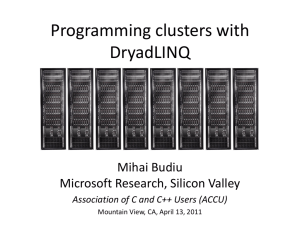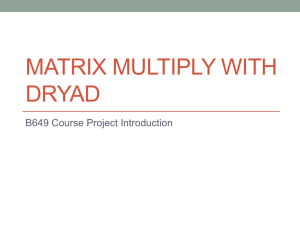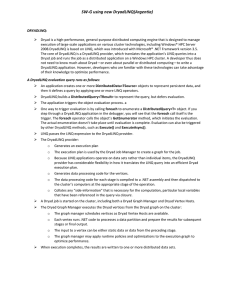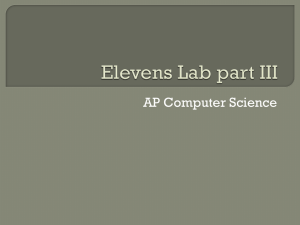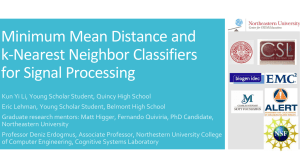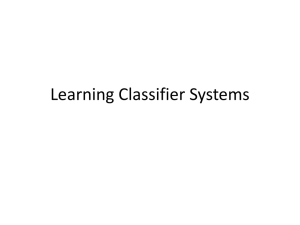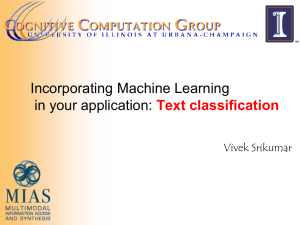The Kinect Body Tracking Pipeline
advertisement
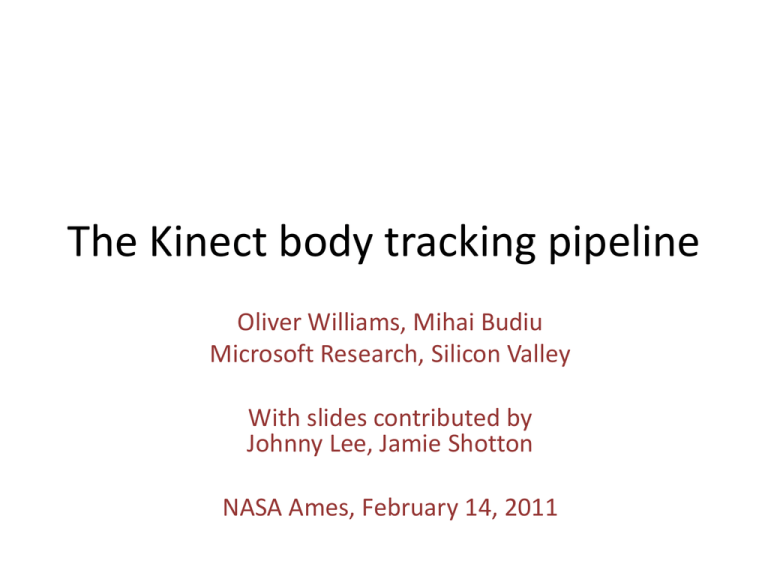
The Kinect body tracking pipeline
Oliver Williams, Mihai Budiu
Microsoft Research, Silicon Valley
With slides contributed by
Johnny Lee, Jamie Shotton
NASA Ames, February 14, 2011
Outline
•
•
•
•
Hardware overview
The body tracking pipeline
Learning a classifier from large data
Conclusions
2
What is Kinect?
3
~2000 people
Caveat: we only have knowledge about a small part of this process.
4
Input device
5
The Innards
Source: iFixit
6
The vision system
RGB
camera
IR
camera
IR laser
projector
Source: iFixit
7
RGB Camera
• Used for face recognition
• Face recognition requires training
• Needs good illumination
8
The audio sensors
• 4 channel multi-array microphone
• Time-locked with console to remove game audio
9
Prime Sense Chip
• Xbox Hardware Engineering dramatically improved
upon Prime Sense reference design performance
• Micron scale tolerances on large components
• Manufacturing process to yield ~1 device / 1.5 seconds
10
Projected IR pattern
11
Source: www.ros.org
Depth computation
Source: http://nuit-blanche.blogspot.com/2010/11/unsing-kinect-for-compressive-sensing.html
12
Depth map
Source: www.insidekinect.com
13
Kinect video output
30 HZ frame rate
57deg field-of-view
8-bit VGA RGB
640 x 480
11-bit monochrome
320 x 240
14
XBox 360 Hardware
• Triple Core PowerPC 970, 3.2GHz
• Hyperthreaded, 2 threads/core
• 500 MHz ATI graphics card
• DirectX 9.5
• 512 MB RAM
• 2005 performance envelope
• Must handle
real-time vision AND
a modern game
Source: http://www.pcper.com/article.php?aid=940&type=expert
15
THE BODY TRACKING PIPELINE
16
Generic Extensible Architecture
Expert 1
fuses the hypotheses
Expert 2
Arbiter
Expert 3
probabilistic
Raw
Sensor
data
Skeleton
Stateless
Statefull
estimates
Final
estimate
17
One Expert: Pipeline Stages
Sensor
Body Part Classifier
Depth map
Background segmentation
Player separation
Body Part
Identification
Skeleton
18
Sample test frames
19
Constraints
• No calibration
- no start/recovery pose
- no background calibration
- no body calibration
• Minimal CPU usage
• Illumination-independent
20
The test matrix
body size
hair
FOV
body type
clothes
angle
pets
furniture
21
Preprocessing
• Identify ground plane
• Separate background (couch)
• Identify players via clustering
22
Two trackers
Hands + head tracking
Body tracking
not exposed through SDK
23
The body tracking problem
Classifier
Input
Depth map
Runs on GPU
@ 320x240
Output
Body parts
24
Training the classifier
• Start from ground-truth data
– depth paired with body parts
• Train classifier to work across
– pose
– scene position
– Height, body shape
25
Getting the Ground Truth (1)
Use synthetic data
(3D avatar model)
• Inject noise
26
Getting the Ground Truth (2)
Motion Capture:
- Unrealistic environments
- Unrealistic clothing
- Low throughput
27
Getting the Ground Truth (3)
Manual Tagging:
-
Requires training many people
Potentially expensive
Tagging tool influences biases in data.
Quality control is an issue
1000 hrs @ 20 contractors ~= 20 years
28
Getting the Ground Truth (4)
Amazon Mechanical Turk:
-
Build web based tool
Tagging tool is 2D only
Quality control can be done with redundant HITS
2000 frames/hr @ $0.04/HIT -> 6 yrs @ $80/hr
29
Classifying pixels
• Compute P(ci|wi)
– pixels i = (x, y)
– body part ci
– image window wi
example image windows
window moves with classifier
• Learn classifier P(ci|wi) from training data
– randomized decision forests
30
Features
𝑓𝜃 𝐼, 𝑥 = 𝑑𝐼 𝑥 +
𝑢
𝑑𝐼 𝑥
-𝑑𝐼 𝑥 +
𝑣
𝑑𝐼 𝑥
𝑑𝐼 𝑥 -- depth of pixel x in image I
𝜃 = (u,v) -- parameter describing offets u and v
31
From body parts to joint positions
•
•
•
•
Compute 3D centroids for all parts
Generates (position, confidence)/part
Multiple proposals for each body part
Done on GPU
32
From joints positions to skeleton
• Tree model of skeleton topology
• Has cost terms for:
– Distances between connected parts
(relative to “body size”)
– Bone proximity to body parts
– Motion terms for smoothness
33
Where is
the skeleton?
34
LEARNING THE BODY PARTS CLASSIFIER
FROM A MOUNTAIN OF DATA
35
Learn from Data
Training examples
Machine learning
Classifier
36
Cluster-based training
Classifier
Training examples
Machine learning
DryadLINQ
•
•
•
•
> Millions of input frames
> 1020 objects manipulated
Sparse, multi-dimensional data
Complex datatypes
(images, video, matrices, etc.)
Dryad
37
Data-Parallel Computation
Application
SQL
Language
Execution
Storage
Parallel
Databases
Sawzall, Java
Sawzall,FlumeJava
≈SQL
LINQ, SQL
Pig, Hive
DryadLINQ
Scope
MapReduce
Hadoop
GFS
BigTable
HDFS
S3
Dryad
Cosmos
Azure
SQL Server
38
Dryad = 2-D Piping
• Unix Pipes: 1-D
grep | sed | sort | awk | perl
• Dryad: 2-D
grep1000 | sed500 | sort1000 | awk500 | perl50
39
Virtualized 2-D Pipelines
40
Virtualized 2-D Pipelines
41
Virtualized 2-D Pipelines
42
Virtualized 2-D Pipelines
43
Virtualized 2-D Pipelines
• 2D DAG
• multi-machine
• virtualized
44
Fault Tolerance
LINQ => DryadLINQ
Dryad
46
LINQ = .Net+ Queries
Collection<T> collection;
bool IsLegal(Key);
string Hash(Key);
var results = from c in collection
where IsLegal(c.key)
select new { Hash(c.key), c.value};
47
DryadLINQ Data Model
.Net objects
Partition
Collection
48
DryadLINQ = LINQ + Dryad
Vertex
code
Collection<T> collection;
bool IsLegal(Key k);
string Hash(Key);
var results = from c in collection
where IsLegal(c.key)
select new { Hash(c.key), c.value};
Query
plan
(Dryad job)
Data
collection
C#
C#
C#
C#
results
49
Language Summary
Where
Select
GroupBy
OrderBy
Aggregate
Join
50
machine
Highly efficient parallellization
time
51
CONCLUSIONS
52
Huge Commercial Success
53
Tremendous Interest from Developers
54
Consumer Technologies
Push The Envelope
Price: 6000$
Price: 150$
55
Unique Opportunity for
Technology Transfer
56
I can finally explain to my son
what I do for a living…
57
